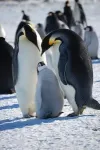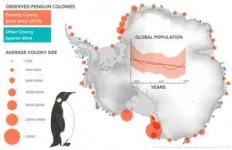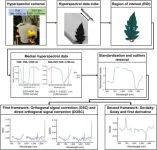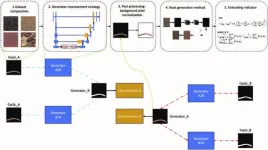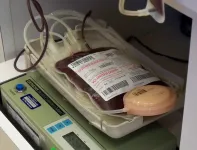(Press-News.org) Woods Hole, Mass. (March 13, 2024) - Emperor penguin populations have been exceedingly difficult to monitor because of their remote locations, and because individuals form breeding colonies on seasonal sea ice fastened to land (known as fast ice) during the dark and cold Antarctic winter.
Now, new research that incorporates very high resolution (VHR) satellite imagery with field-based validation surveys and long-term data has provided the first multi-year time series that documents emperor penguin global population trends.
Researchers observed nearly 10% fewer birds in 2018 compared with in 2009, according to a new study that used VHR satellite imagery with 30–60-centimeter ground resolution to examine the entirety of the penguins’ range during springtime around the Antarctic coast. The research appears in the journal article, “Advances in remote sensing of emperor penguins: first multi-year time series documenting trends in the global population,” published in the journal Proceedings of the Royal Society B.
Scientists cannot yet explain the population trend. However, additional research should help with a better understanding of the causal factors – including the role of climate change. Further, this new monitoring methodology could help in the development of adaptive conservation management efforts.
“What we did in this paper, and through international collaborative research, was to develop the state-of-the-art approach to monitoring emperor penguins across all of Antarctica, including in remote places that are inhospitable to people. Having the very high resolution satellite imagery is a breakthrough in our understanding of the spatial distribution of emperor penguins, and having this global population trend is very important for conservation,” said journal article senior author Stephanie Jenouvrier, senior scientist in the Woods Hole Oceanographic Institution’s Biology Department.
Jenouvrier noted that the computer modeling takes into account many processes and uncertainties related to penguin population and life history.
“Although we cannot yet clearly attribute this penguin population trend to any particular mechanism such as climate change, there is an accumulation of evidence that the environment is changing and it does not seem to be an environment where penguins are going to endure,” Jenouvrier explained.
The researchers say that the results from the study gives them the potential to make more informed predictions combining monitoring methods and technologies (e.g., field-based, and remote sensing). They note that these will require evaluation of assumptions regarding observation and data processing errors.
“Our work documents change in an iconic polar seabird and shows how useful remote sensing can be to understand animals that live in wild places,” according to journal article co-lead author Michelle LaRue, who is an associate professor at University of Canterbury in New Zealand and research associate at the University of Minnesota Twin Cities in the United States. “In a rapidly changing world, we have to constantly push the envelope to combine new approaches with tried-and-true methods if we want to understand the consequences of that change, especially in places we cannot get to.”
LaRue said combining satellite images with animal tracking, ground observations and molecular tools (like genetic analysis) will be needed if they want to fully understand mechanisms to describe some of the changes they observe.
During the course of the study, researchers detected several new colonies, bringing the total to 66 known colony locations. It is now highly probable that most emperor penguin colony locations have been detected, with about half having been detected with satellite imagery, according to the paper.
In addition, the research identified the East Indian Ocean and Weddell Sea areas of Antarctica as being the two sectors of the continent where there is the greatest probability of declines in regional populations of emperor penguins. These are locations where the extent of fast ice generally has decreased in recent decades. Emperor penguins primarily form colonies and rear their chicks on fast ice.
“We don’t understand the population trend in full, and we need to do more research. However, the fact that we have detected a population trend in such a short data set is really important because it potentially has major implications for the future of the species,” said journal article co-author Philip Trathan, an emeritus fellow with the British Antarctic Survey where he previously was head of conservation ecology. “Projections indicate that emperor penguins are going to be struggling to survive into the future. So, having tools that allow us to ground truth some of the population models in the future will be really important.”
The journal article authors said that with this new methodology, there is now a way forward to assess the population status and trends of emperor penguins at a global scale, which provides an invaluable tool for adaptive conservation planning in a changing Southern Ocean.
Funding for this research was provided by the National Science Foundation, NASA; the French Polar Institute Paul-Émile Victor, Alfred Wegener Institute for Polar and Marine Research in the Helmholtz Association, World Wide Fund for Nature (UK), and the German Research Foundation.
END
High resolution imagery advances the ability to monitor decadal changes in emperor penguin populations
Researchers report nearly 10% fewer birds, according to new study
2024-03-13
ELSE PRESS RELEASES FROM THIS DATE:
Gilbert H. L. Tang appointed Editor-in-Chief of JACC: Case Reports
2024-03-13
Renowned cardiovascular surgeon Gilbert H. L. Tang has been named Editor-in-Chief of JACC: Case Reports, bringing a wealth of experience and expertise to the helm of one of the top cardiovascular journals published by the American College of Cardiology.
“I am both honored and humbled to be a cardiac surgeon among the Editor-in-Chiefs in the JACC family of journals,” Tang said. “It is going to be an exciting time for JACC: Case Reports to build on a team of multidisciplinary cardiovascular practitioners with diverse backgrounds and experiences, and at different stages of their professional careers, to enhance the journal’s academic and educational impact globally.”
Tang ...
Enhancing crop nutritional analysis: a leap towards precision agriculture with multi-target regression and hyperspectral imaging
2024-03-13
Recent advancements in hyperspectral imaging and machine learning have revolutionized the non-destructive monitoring of crop nutritional status, enabling accurate prediction of plant element concentrations. Despite successes, the single-target regression method, which predicts concentrations individually, faces accuracy limitations for certain elements. Traditional methods offer accuracy but at the cost of being destructive and inefficient for large-scale use. Current research highlights the potential of multi-target ...
Sonic youth: Healthy reef sounds increase coral settlement
2024-03-13
Woods Hole, Mass. – A healthy coral reef is noisy, full of the croaks, purrs, and grunts of various fishes and the crackling of snapping shrimp. Research suggests that larval animals use this symphony of sounds to help them determine where they should live and grow.
Researchers at the Woods Hole Oceanographic Institution (WHOI) recently demonstrated that replaying healthy reef sounds could potentially be used to encourage coral larvae to recolonize damaged or degraded reefs. A reef that has been ...
Warwick awarded £11 million to train PhD students in computational modelling
2024-03-13
The University of Warwick has been awarded £11m to train PhD students in computational modelling.
The new centre will train 50 PhD students to use computational modelling to tackle pressing global sustainability challenges from accessing clean fusion energy, controlling infectious diseases, to designing energy-efficient devices such as new battery electrolytes.
The Centre for Doctoral Training in Modelling of Heterogeneous Systems (HetSys II), led by Professor James Kermode from the School of Engineering, Dr Livia Bartok-Partay from Chemistry and Professor Nicholas Hine from Physics, will train ...
Simple trick could improve accuracy of plant genetics research
2024-03-13
Researchers have published a simple trick that improves the accuracy of techniques that help us understand how external variables – such as temperature – affect gene activity in plants.
“There are really two contributions here,” says Colleen Doherty, corresponding author of a paper on the work and an associate professor of molecular and structural biochemistry at North Carolina State University. “First, we’re raising the visibility of a problem that many of us in the ...
Revolutionizing plant science: a groundbreaking method for expanding in situ root datasets using CycleGAN
2024-03-13
The root system is crucial for plants to absorb water and nutrients, with in situ root research providing insights into root phenotypes and dynamics. While deep-learning-based root segmentation methods have advanced the analysis of root systems, they require extensive manually labeled datasets, which are labor-intensive and time-consuming to produce. Current methods of in situ root observation vary in their effectiveness. Moreover, traditional root image recognition methods face challenges such as subjectivity and ...
COVID-19 rebound after VV116 vs nirmatrelvir-ritonavir treatment
2024-03-13
About The Study: In this randomized clinical trial of 345 patients with mild-to-moderate COVID-19, viral load rebound and symptom rebound were both common after a standard 5-day course of antiviral treatment with either VV116 or nirmatrelvir-ritonavir. Prolongation of treatment duration might be investigated to reduce COVID-19 rebound.
Authors: Yufang Bi, M.D., and Yiping Xu, M.Sc., of the Shanghai Jiao Tong University School of Medicine in Shanghai, China, are the corresponding authors.
To access the embargoed study: Visit our For ...
Mental well-being among adversity-exposed adolescents during the pandemic
2024-03-13
About The Study: The findings of this study of 4,515 adolescents suggest that in-person schooling and several coping behaviors (caring for one’s body, exercising, and engaging in healthy behaviors) were associated with significantly higher positive affect and lower perceived stress during the COVID-19 pandemic among adolescents with high adverse childhood experiences (ACEs). Adolescents with high ACEs demonstrated especially greater mental health scores when they reported in-person schooling. Future studies should build on these findings to identify clinical and school-based mental health protective ...
Enhancing plant photochemistry analysis: a novel approach to chlorophyll a fluorescence measurement under environmental stress
2024-03-13
Chlorophyll a fluorescence (ChlF) has been a pivotal tool in understanding plant photochemistry, offering insights into the energy transfer processes within chloroplasts and the efficiency of Photosystem II (PSII). Researchers have relied on quantifying ChlF through specific measures such as F0, Fm, and Fv under various lighting conditions to assess photosynthetic activities. Nonetheless, the technique encounters obstacles owing to the intrinsic uncertainties in gauging the absolute magnitude of ChlF and the fluctuation in baseline levels affected by environmental conditions. This complicates the interpretation of ...
It’s in the blood: donor diets can trigger allergic reactions in blood recipients
2024-03-13
Allergic transfusion reactions (ATRs), a potentially life-threatening side effect of blood transfusions with unclear mechanisms, may be linked to food allergies in pediatric patients as per a recent study by scientists from Japan. They found that ATRs may be triggered by the presence of allergens in the donor’s blood, influenced by their pre-donation diet. These findings could pave the way for safer blood transfusions through the development of preventive measures and countermeasures for ATRs.
Blood transfusions are often life-saving procedures in various medical settings. They are required not only after severe blood loss ...
LAST 30 PRESS RELEASES:
New expert guidance urges caution before surgery for patients with treatment-resistant constipation
Solar hydrogen can now be produced efficiently without the scarce metal platinum
Sleeping in on weekends may help boost teens’ mental health
Study: Teens use cellphones for an hour a day at school
After more than two years of war, Palestinian children are hungry, denied education and “like the living dead”
The untold story of life with Prader-Willi syndrome - according to the siblings who live it
How the parasite that ‘gave up sex’ found more hosts – and why its victory won’t last
When is it time to jump? The boiling frog problem of AI use in physics education
Twitter data reveals partisan divide in understanding why pollen season's getting worse
AI is quick but risky for updating old software
Revolutionizing biosecurity: new multi-omics framework to transform invasive species management
From ancient herb to modern medicine: new review unveils the multi-targeted healing potential of Borago officinalis
Building a global scientific community: Biological Diversity Journal announces dual recruitment of Editorial Board and Youth Editorial Board members
Microbes that break down antibiotics help protect ecosystems under drug pollution
Smart biochar that remembers pollutants offers a new way to clean water and recycle biomass
Rice genes matter more than domestication in shaping plant microbiomes
Ticking time bomb: Some farmers report as many as 70 tick encounters over a 6-month period
Turning garden and crop waste into plastics
Scientists discover ‘platypus galaxies’ in the early universe
Seeing thyroid cancer in a new light: when AI meets label-free imaging in the operating room
Neutrophil-to-lymphocyte ratio may aid risk stratification in depressive disorder
2026 Seismological Society of America Annual Meeting
AI-powered ECG analysis offers promising path for early detection of chronic obstructive pulmonary disease, says Mount Sinai researchers
GIMM uncovers flaws in lab-grown heart cells and paves the way for improved treatments
Cracking the evolutionary code of sleep
Medications could help the aging brain cope with surgery, memory impairment
Back pain linked to worse sleep years later in men over 65, according to study
CDC urges ‘shared decision-making’ on some childhood vaccines; many unclear about what that means
New research finds that an ‘equal treatment’ approach to economic opportunity advertising can backfire
Researchers create shape-shifting, self-navigating microparticles
[Press-News.org] High resolution imagery advances the ability to monitor decadal changes in emperor penguin populationsResearchers report nearly 10% fewer birds, according to new study

